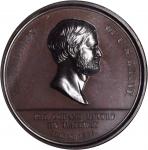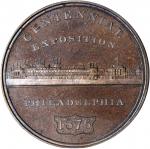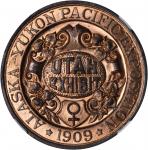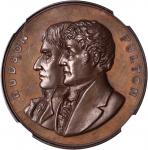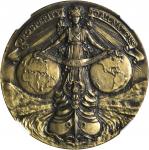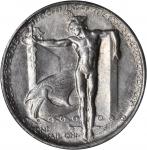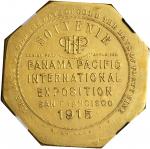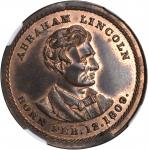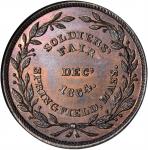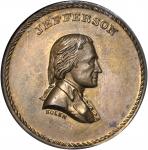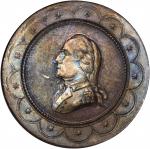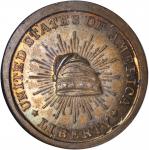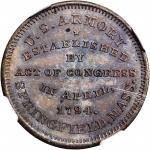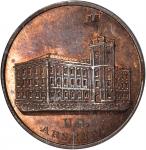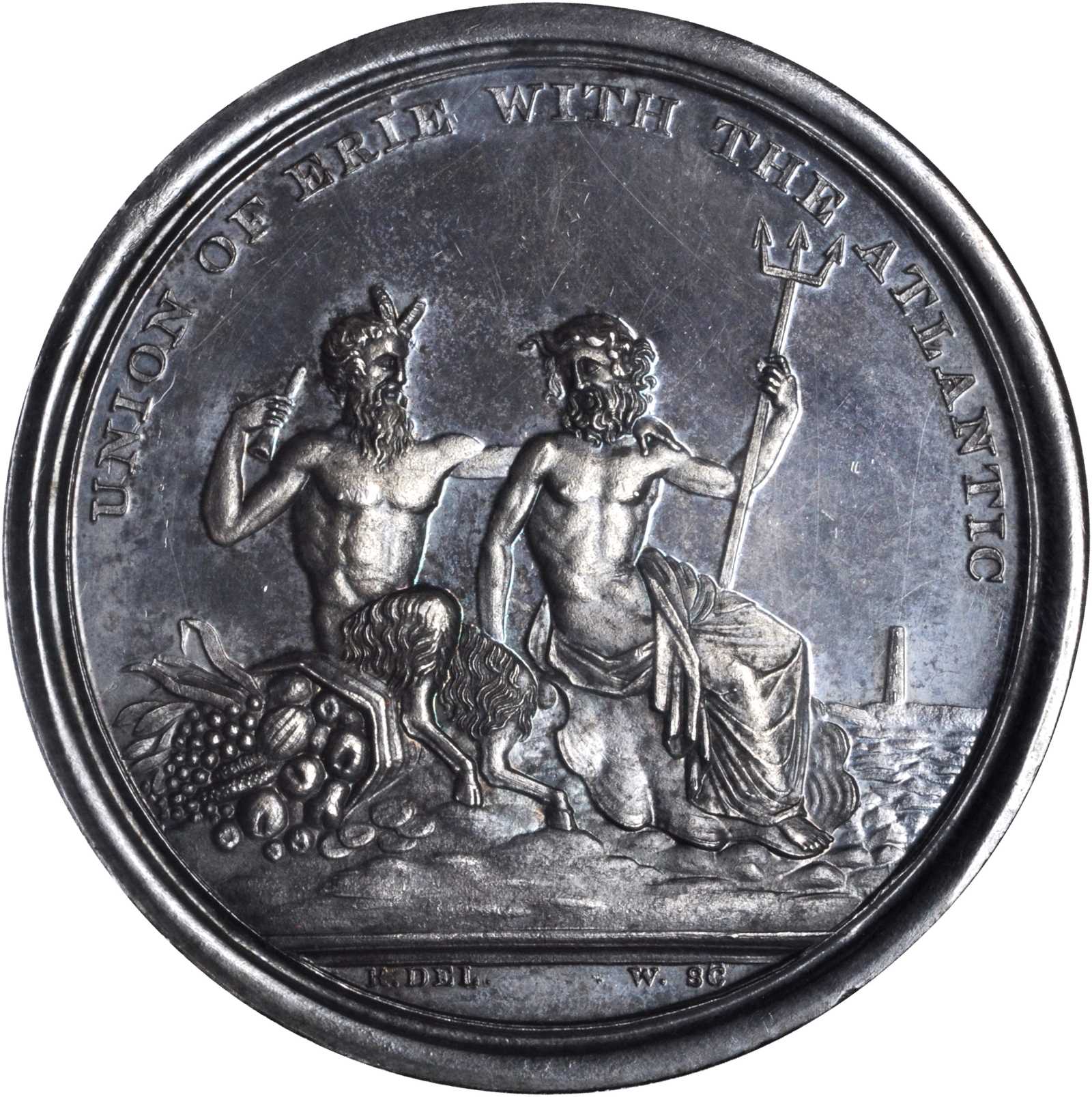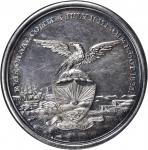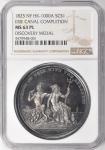(1826) Erie Canal Completion Medal. Silver. 30.04 grams, 44.0 mm, 2.4 mm thick. HK-1000a. Rarity-10 (Unique). First Reverse. MS-63 PL (NGC).
When completed on October 26, 1825, the Erie Canal was an engineering marvel that was nearly four decades in the making, having first been proposed in the 1780s. The canal connected Buffalo and the Great Lakes in the west to Albany and the Hudson River in the east, and by extension to New York City and the Atlantic Ocean via the Hudson River. Its completion ushered in an era of economic, cultural and political prosperity in New York and specifically New York City, whose increasing importance as a port city outpaced those of competing ports along the eastern seaboard. The Canal was famous with bringing the agricultural products of the western interior to markets in the east, and bringing finished goods from the port of New York City to the interior, all the while slashing the cost of transportation by 95% from the usual overland routes.
A medal befitting the national importance of the canals completion was authorized by the Common Council of New York City, which put its execution in the able hands of Archibald Robertson, a contemporary American artist. Detailed information about the medals is found in Robertsons report in the 1826 publication of <em>An Account of the Grand Canal Celebration at New York November the Fourth 1825</em>, which itself is an appendix to Cadwallader Coldens 1825<em> Memoir</em> detailing the evolution of the Erie Canal. We learn that Robertson himself designed the medal, that iron and steel worker William Williams made the dies upon which famed medalist Charles Cushing Wright engraved the designs and Richard Trested punched the legends. The medals themselves were struck by Maltby Pelletreau of Pelletreau, Bennett and Cooke, Pelletreau being from a family of New York silversmiths dating back to colonial times.
Robertson writes that "The first of my operations was to make an appropriate Device, intended for a Medal, to be worn by the guests of the Corporation [of the City of New York] on the joyful day; but time not permitting the execution of such a work as would be worthy of the occasion, it was resolved to have the Device engraved by a first-rate artist, and postpone the Medal to be executed at leisure…" A satin badge was created in lieu of the medals, using Robertsons design for the "device," a version of which appears on the medals that were eventually struck. Robertson does not elucidate when the medals were actually made, which had to be sometime between the grand November 4, 1825 New York City celebration of the opening in the canal and the eyewitness account of a medal published in the April 25, 1826 issue of American Traveler, which was referenced in the August 10, 2003 issue of the E-Sylum.<br /><br />Most known Erie Canal medals are in Gold (HK-1001), Silver (HK-1000), or White Metal (HK-1, called "semi-metal" or "composition" in Robertsons report), all of which share the same obverse and reverse:
Obverse 1: at left, Pan seated on an overflowing cornucopia representing the bounty of the Great Lakes and the western lands embraces Neptune, representing the connection to the waters of the Atlantic Ocean, the waves and the lighthouse of Sandy Hook (NJ) visible in the distance, the legend UNION OF ERIE WITH THE ATLANTIC is above, in exergue are R. DEL. and W. SC, abbreviations for "Robertson Designed It" and "Wright Sculpted It."<br /><br />Reverse B (Second Reverse): arms of the State of New York at the center, the locks and aqueducts of the Erie Canal to the left, the harbor and city of New York to the right, the legends read ERIE CANAL COMM. 4 JULY 1817 COMP. 26 OCT. 1825, in exergue C. C. WRIGHT SC. / 1826 / PRESENTED BY THE CITY OF NEW YORK.
The present example in silver is a newly discovered die pairing, designated HK-1000a by NGC and sharing obverse 1 as described above, but with a wholly different and previously unrecorded reverse:<br /><br />Reverse A (First Reverse): the new reverse design is similar in general outlines to Reverse B, but is greatly different in detail and execution, being generally bolder. The arms of New York are larger and lower in the field, the eagles wings are shown outstretched to left and right rather than its left wing shown pulled back, a large grassy area replaces all the exergual legends, hills now overlook the locks and aqueducts, which are fewer and at the right (rather than the left), and the New York City and harbor view is larger and now at the left, rather than the right. <br /><br />Interestingly enough, a close reading of Robertsons description of the medal reveals that it is a mixing of Reverses A and B. He seems to be describing Reverse A: "On the reverse is the Armorial Bearings of the State, the sole agent in the great work; on the right of which are appropriately represented Canal Aqueducts and Locks; and on the left is a view of the Harbor and City of New York." But he goes on to detail the mottos and other legends that are on Reverse B, but his description of the orientation of the locks and New York City view are clearly that of Reverse A. He does not mention the medal being dated, which is more like Reverse A than B. Also interesting is that the supposed eyewitness account referenced above follows Robertsons description, and given the other details about the production of the medal published in that account, we surmise it was taken from Robertsons report and not from the medal itself.
This newly discovered reverse A die of HK-1000a shows a clear bisecting crack from about 2 oclock through the arms, ship and to the rim around 8 oclock, the crack extending upward from the ship through ER of ERIE to the rim around 9 oclock. The die had clearly failed, and had to be removed from service early on, as no other survivors of this die combination have been reported since the medals creation nearly 200 years ago. Both dies are sharp, unworn and prooflike on this medal, indicating that this is an early strike from fresh dies. We believe this discovery medal to be an early strike utilizing a reverse die whose failure required the execution of a new reverse die, Reverse B above, which is the one known to numismatics until now. The designs were slightly modified, and most importantly, a date, engraver and sponsor were added in the exergue.
At some point in the production of the Erie Canal medals, the obverse die common to both die pairings cracked from Pans hand through his torso to the top of the cornucopia and beyond; as it is wholly absent on this newly discovered HK-1000a, HK-1000a must have been struck before the HK-1, HK-1000, and HK-1001, many of which show some signs of the die crack. Given the lack of a date on HK-1000a, and that it was struck before the main group of Erie Canal Completion medals that are actually dated 1826, NGC has dated this medal to 1825, which is a possibility that cant be verified with the information currently at hand. Perhaps archival evidence will one day be discovered detailing the chronology of production.
Whether this medal was sent to one of the participants of the November 4, 1825 celebration or saved by someone involved in the manufacture of this ill-fated initial production is probably unknowable today. Its modern discovery was serendipitous. Our Vice President of Numismatics, Vicken Yegparian, sat down with the consignor at his table at the August 2017 ANA Convention in Denver, and having an interest in Erie Canal medals, asked to see a new one he had in his case. After a few moments of examination, Vicken could see that something was not quite right, but couldnt put his finger on it. How could the reverse be so badly cracked, when the obverse was perfect, and most known survivors have a crack on the obverse and not on the reverse? Only after comparing this photo with that of a specimen in Stacks Bowers archives via our mobile app did Vicken realize that the reverse was totally different than that on the usually seen Erie Canal Medals. After the elation of their discovery died down a bit, it was decided that the appropriate venue for the sale of this previously unknown Erie Canal Medal type would be the present sale.
This beautiful medal is crisply and fully struck, highlighting the fine details of Robertsons design and Wrights able engraving, its fields prooflike on both sides, its surfaces richly toned in steely blue and gray, the obverse a bit more deeply than the reverse, which boasts hints of rose and blue iridescence. The obverse is essentially Gem, the reverse displays some minor hairlines in the wide open fields. The reverse must have been loose in the die, as it shows three distinct strikes, most clearly visible in the eagles wings, in the legends from 12 oclock to 3 oclock, and in the large bisecting die crack. Accompanying this medal is half of one of the original two piece wood boxes that were specially made from wood "brought from Erie in the first Canal Boat The Seneca Chief."
This is a unique major variant of a historic medal commemorating an event of great national importance whose lasting economic influence resonates to this day, though the Erie Canal today is a mere shadow of its mid-19th century heyday. It is one of the most significant discoveries in the field of early American medals in recent years and will be avidly pursued by collectors of rare early American medals, students of American history, and serious collectors of So-Called Dollars.

